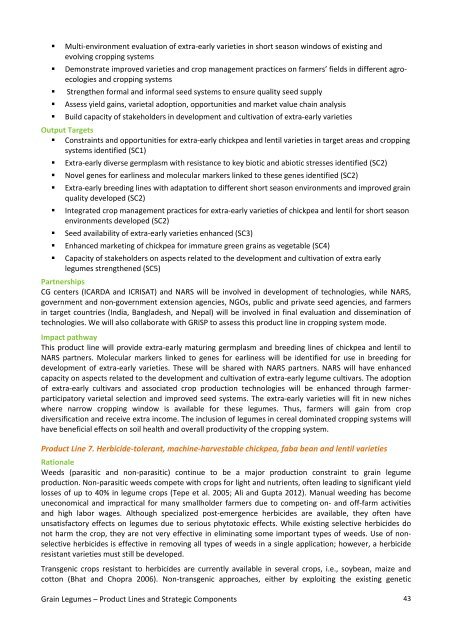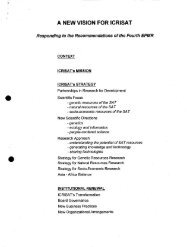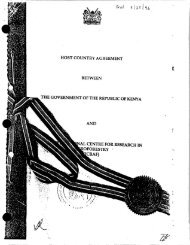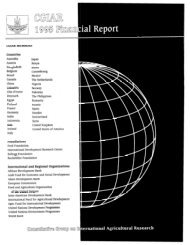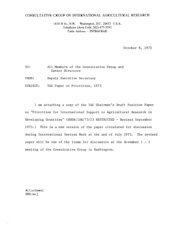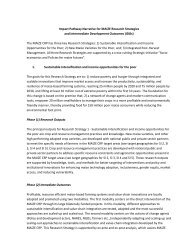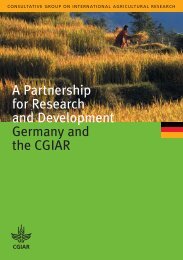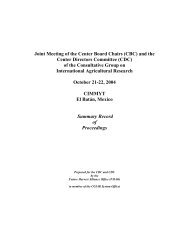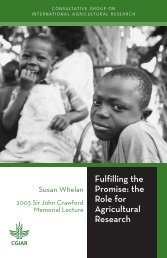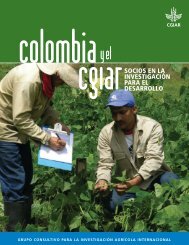CGIAR Research Program on Grain Legumes: Proposal - Library
CGIAR Research Program on Grain Legumes: Proposal - Library
CGIAR Research Program on Grain Legumes: Proposal - Library
- No tags were found...
You also want an ePaper? Increase the reach of your titles
YUMPU automatically turns print PDFs into web optimized ePapers that Google loves.
• Multi-envir<strong>on</strong>ment evaluati<strong>on</strong> of extra-early varieties in short seas<strong>on</strong> windows of existing andevolving cropping systems• Dem<strong>on</strong>strate improved varieties and crop management practices <strong>on</strong> farmers’ fields in different agroecologiesand cropping systems• Strengthen formal and informal seed systems to ensure quality seed supply• Assess yield gains, varietal adopti<strong>on</strong>, opportunities and market value chain analysis• Build capacity of stakeholders in development and cultivati<strong>on</strong> of extra-early varietiesOutput Targets• C<strong>on</strong>straints and opportunities for extra-early chickpea and lentil varieties in target areas and croppingsystems identified (SC1)• Extra-early diverse germplasm with resistance to key biotic and abiotic stresses identified (SC2)• Novel genes for earliness and molecular markers linked to these genes identified (SC2)• Extra-early breeding lines with adaptati<strong>on</strong> to different short seas<strong>on</strong> envir<strong>on</strong>ments and improved grainquality developed (SC2)• Integrated crop management practices for extra-early varieties of chickpea and lentil for short seas<strong>on</strong>envir<strong>on</strong>ments developed (SC2)• Seed availability of extra-early varieties enhanced (SC3)• Enhanced marketing of chickpea for immature green grains as vegetable (SC4)• Capacity of stakeholders <strong>on</strong> aspects related to the development and cultivati<strong>on</strong> of extra earlylegumes strengthened (SC5)PartnershipsCG centers (ICARDA and ICRISAT) and NARS will be involved in development of technologies, while NARS,government and n<strong>on</strong>-government extensi<strong>on</strong> agencies, NGOs, public and private seed agencies, and farmersin target countries (India, Bangladesh, and Nepal) will be involved in final evaluati<strong>on</strong> and disseminati<strong>on</strong> oftechnologies. We will also collaborate with GRiSP to assess this product line in cropping system mode.Impact pathwayThis product line will provide extra-early maturing germplasm and breeding lines of chickpea and lentil toNARS partners. Molecular markers linked to genes for earliness will be identified for use in breeding fordevelopment of extra-early varieties. These will be shared with NARS partners. NARS will have enhancedcapacity <strong>on</strong> aspects related to the development and cultivati<strong>on</strong> of extra-early legume cultivars. The adopti<strong>on</strong>of extra-early cultivars and associated crop producti<strong>on</strong> technologies will be enhanced through farmerparticipatoryvarietal selecti<strong>on</strong> and improved seed systems. The extra-early varieties will fit in new nicheswhere narrow cropping window is available for these legumes. Thus, farmers will gain from cropdiversificati<strong>on</strong> and receive extra income. The inclusi<strong>on</strong> of legumes in cereal dominated cropping systems willhave beneficial effects <strong>on</strong> soil health and overall productivity of the cropping system.Product Line 7. Herbicide-tolerant, machine-harvestable chickpea, faba bean and lentil varietiesRati<strong>on</strong>aleWeeds (parasitic and n<strong>on</strong>-parasitic) c<strong>on</strong>tinue to be a major producti<strong>on</strong> c<strong>on</strong>straint to grain legumeproducti<strong>on</strong>. N<strong>on</strong>-parasitic weeds compete with crops for light and nutrients, often leading to significant yieldlosses of up to 40% in legume crops (Tepe et al. 2005; Ali and Gupta 2012). Manual weeding has becomeunec<strong>on</strong>omical and impractical for many smallholder farmers due to competing <strong>on</strong>- and off-farm activitiesand high labor wages. Although specialized post-emergence herbicides are available, they often haveunsatisfactory effects <strong>on</strong> legumes due to serious phytotoxic effects. While existing selective herbicides d<strong>on</strong>ot harm the crop, they are not very effective in eliminating some important types of weeds. Use of n<strong>on</strong>selectiveherbicides is effective in removing all types of weeds in a single applicati<strong>on</strong>; however, a herbicideresistant varieties must still be developed.Transgenic crops resistant to herbicides are currently available in several crops, i.e., soybean, maize andcott<strong>on</strong> (Bhat and Chopra 2006). N<strong>on</strong>-transgenic approaches, either by exploiting the existing genetic<strong>Grain</strong> <strong>Legumes</strong> – Product Lines and Strategic Comp<strong>on</strong>ents 43


